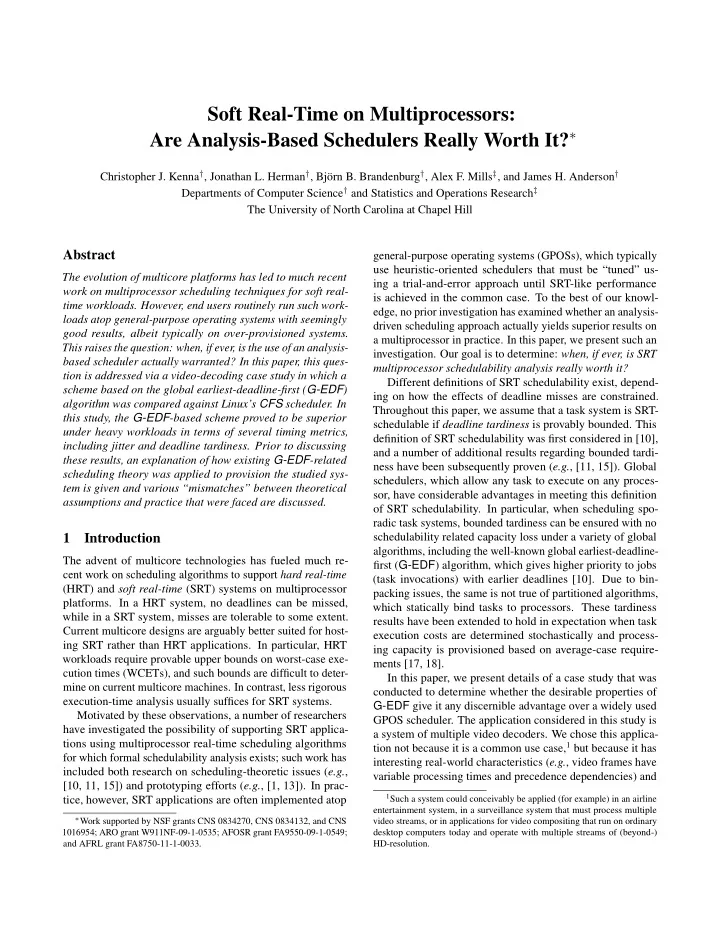

Soft Real-Time on Multiprocessors: Are Analysis-Based Schedulers Really Worth It? ∗ Christopher J. Kenna † , Jonathan L. Herman † , Bj¨ orn B. Brandenburg † , Alex F. Mills ‡ , and James H. Anderson † Departments of Computer Science † and Statistics and Operations Research ‡ The University of North Carolina at Chapel Hill Abstract general-purpose operating systems (GPOSs), which typically use heuristic-oriented schedulers that must be “tuned” us- The evolution of multicore platforms has led to much recent ing a trial-and-error approach until SRT-like performance work on multiprocessor scheduling techniques for soft real- is achieved in the common case. To the best of our knowl- time workloads. However, end users routinely run such work- edge, no prior investigation has examined whether an analysis- loads atop general-purpose operating systems with seemingly driven scheduling approach actually yields superior results on good results, albeit typically on over-provisioned systems. a multiprocessor in practice. In this paper, we present such an This raises the question: when, if ever, is the use of an analysis- investigation. Our goal is to determine: when, if ever, is SRT based scheduler actually warranted? In this paper, this ques- multiprocessor schedulability analysis really worth it? tion is addressed via a video-decoding case study in which a Different definitions of SRT schedulability exist, depend- scheme based on the global earliest-deadline-first ( G-EDF ) ing on how the effects of deadline misses are constrained. algorithm was compared against Linux’s CFS scheduler. In Throughout this paper, we assume that a task system is SRT- this study, the G-EDF -based scheme proved to be superior schedulable if deadline tardiness is provably bounded. This under heavy workloads in terms of several timing metrics, definition of SRT schedulability was first considered in [ 10 ], including jitter and deadline tardiness. Prior to discussing and a number of additional results regarding bounded tardi- these results, an explanation of how existing G-EDF -related ness have been subsequently proven ( e.g. , [ 11 , 15 ]). Global scheduling theory was applied to provision the studied sys- schedulers, which allow any task to execute on any proces- tem is given and various “mismatches” between theoretical sor, have considerable advantages in meeting this definition assumptions and practice that were faced are discussed. of SRT schedulability. In particular, when scheduling spo- radic task systems, bounded tardiness can be ensured with no 1 Introduction schedulability related capacity loss under a variety of global algorithms, including the well-known global earliest-deadline- The advent of multicore technologies has fueled much re- first ( G-EDF ) algorithm, which gives higher priority to jobs cent work on scheduling algorithms to support hard real-time (task invocations) with earlier deadlines [ 10 ]. Due to bin- (HRT) and soft real-time (SRT) systems on multiprocessor packing issues, the same is not true of partitioned algorithms, platforms. In a HRT system, no deadlines can be missed, which statically bind tasks to processors. These tardiness while in a SRT system, misses are tolerable to some extent. results have been extended to hold in expectation when task Current multicore designs are arguably better suited for host- execution costs are determined stochastically and process- ing SRT rather than HRT applications. In particular, HRT ing capacity is provisioned based on average-case require- workloads require provable upper bounds on worst-case exe- ments [17, 18]. cution times (WCETs), and such bounds are difficult to deter- In this paper, we present details of a case study that was mine on current multicore machines. In contrast, less rigorous conducted to determine whether the desirable properties of execution-time analysis usually suffices for SRT systems. G-EDF give it any discernible advantage over a widely used Motivated by these observations, a number of researchers GPOS scheduler. The application considered in this study is have investigated the possibility of supporting SRT applica- a system of multiple video decoders. We chose this applica- tions using multiprocessor real-time scheduling algorithms tion not because it is a common use case, 1 but because it has for which formal schedulability analysis exists; such work has interesting real-world characteristics ( e.g. , video frames have included both research on scheduling-theoretic issues ( e.g. , variable processing times and precedence dependencies) and [ 10 , 11 , 15 ]) and prototyping efforts ( e.g. , [ 1 , 13 ]). In prac- 1 Such a system could conceivably be applied (for example) in an airline tice, however, SRT applications are often implemented atop entertainment system, in a surveillance system that must process multiple ∗ Work supported by NSF grants CNS 0834270, CNS 0834132, and CNS video streams, or in applications for video compositing that run on ordinary 1016954; ARO grant W911NF-09-1-0535; AFOSR grant FA9550-09-1-0549; desktop computers today and operate with multiple streams of (beyond-) and AFRL grant FA8750-11-1-0033. HD-resolution.
Recommend
More recommend